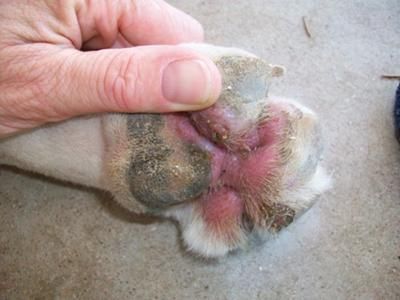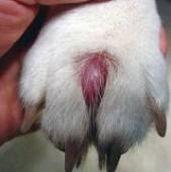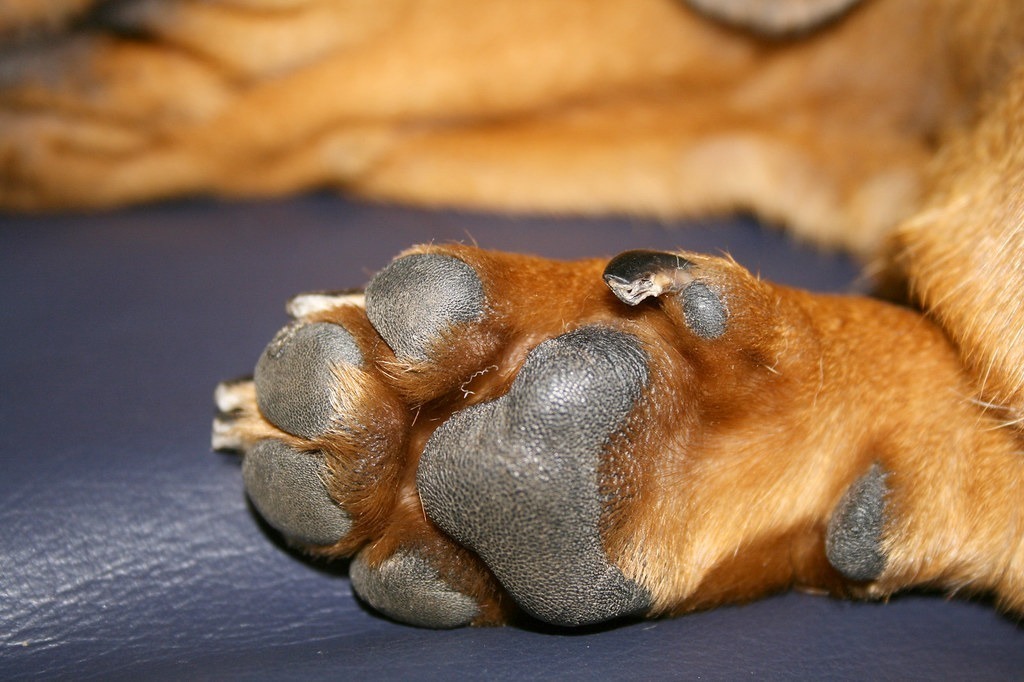One of the more common reasons for pet owners to present their pets for evaluation by a veterinarian is red, inflamed paws. The general term for skin inflammation of the paws is called pododermatitis. This week’s post is dedicated to sharing detailed information for families about this common condition in their furry companions. Happy reading!

Pododermatitis – What is it?
Pododermatitis is not a specific disease. Rather, it is a descriptive term for inflammation of the skin of the paws. There are multiple causes of pododermatitis, including:
- Infectious diseases – bacteria, fungi, parasites, viruses, protozoa
- Immune-mediated conditions – atopy, food allergies, pemphigus foliaceous, lupoid onychodystrophy, erythema multiforme
- Cancers – squamous cell carcinoma, epitheliotropic lymphoma
- Hormone & systemic disorders – hypothyroidism, hyperadrenocorticism (Cushing’s disease), superficial necrolytic dermatitis / hepatocutaneous syndrome)
- Genetic & inherited ailments
- Acquired conditions – foreign body (e.g.: foxtails, awn, thorn), interdigital follicular cysts, embedded hair shafts, trauma, osteomyelitis, arteriovenous fistula, acral lick granuloma, zinc responsive dermatitis type II, arthritis, osteomyelitis

What does it look like?
Pets of any age, sex, and breed may develop pododermatitis. With that being said, some conditions are more commonly associated with certain breeds than others. Dogs develop this condition more frequently than cats.
Our pets carry the majority of their weight on their front paws. For this reason, the front paws are more commonly affected the the hind paws. Clinical signs associated with pododermatitis include:
- Reddened paw skin
- Paw pain
- Salivary staining
- Chewing of affected feet
- Alopecia (aka hair loss)
- Skin pigment changes
- Masses between toes
- Changes to paw pads
- Blisters & ulcers
- Comedones (aka “black heads”)
- Edema (i.e.: swelling)
- Pustular / oozing lesions

How is pododermatitis diagnosed?
Veterinarians will review your pet’s thorough medical history. Particular attention should be paid to answering the following questions:
- Is your pet pruritic (aka itchy)?
- Are the clinical signs seasonal?
- At what age did clinical signs manifest?
- In what type of environment is your pet housed?
- What’s your pet’s activity level?
- Are other body parts affected?
Based on your pet’s history and the distribution of their skin lesions, veterinarians will recommend testing to help identify the underlying cause(s) of your pet’s reddened paws. These tests may include:
- Skin tests – cytology, culture, scrapings, and/or biopsies
- Trichrography (microscopic hair evaluation)
- Metabolic & hormonal screening
- Infectious disease screening (depending on your geographic location)
- Radiographs (x-rays) of affected paws
The vast majority of primary care veterinarians are fully capable of diagnosing the vast majority of the causes of pododermatitis. For more challenging patients, families may find it helpful to consult with a board-certified veterinary dermatologist to develop a logical and cost-effective diagnostic plan.

How is it treated?
Definitive treatment of pododermatitis requires accurate identification of the underlying cause. Therapies may include topical ointments, systemic drugs, and/or surgery. Some conditions are curable while others require long-term interventions and follow-up examinations with your pet’s veterinary medical team. Families are encouraged to partner with a board-certified veterinary dermatologist for any pet who is not responding appropriately to prescribed therapies.
The take-away message about pododermatitis…
Pododermatitis is a descriptive term for reddened inflamed paws. There are multiple causes of pododermatitis, and effective management requires accurated identification of the underlying cause. A pet’s prognosis depends on the cause(s) of a pet’s reddened paws and their response to prescribed therapies.
To find a board-certified veterinary dermatologist, please visit the American College of Veterinary Dermatology.
Wishing you wet-nosed kisses,
CriticalCareDVM




